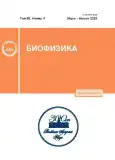Use of peroxiredoxin 6 to prevent liver dysfunction in acute kidney injury
- Authors: Gordeeva A.E1, Kurganova E.A2, Novoselov V.I1
-
Affiliations:
- Institute of Cell Biophysics, Russian Academy of Sciences
- Pushchino State Natural Science Institute
- Issue: Vol 68, No 4 (2023)
- Pages: 770-779
- Section: Articles
- URL: https://journals.rcsi.science/0006-3029/article/view/142132
- DOI: https://doi.org/10.31857/S000630292304018X
- EDN: https://elibrary.ru/KNAIRU
- ID: 142132
Cite item
Full Text
Abstract
About the authors
A. E Gordeeva
Institute of Cell Biophysics, Russian Academy of SciencesPushchino, Moscow Region, Russia
E. A Kurganova
Pushchino State Natural Science InstitutePushchino, Moscow Region, Russia
V. I Novoselov
Institute of Cell Biophysics, Russian Academy of Sciences
Email: novoselov-vi@rambler.ru
Pushchino, Moscow Region, Russia
References
- K. Lane, J. J. Dixon, I. MacPhee, et al., Nephrol. Dial. Transplant., 28 (17), 1634 (2013).
- M. E. Grams and H. Rabb, Kidney Int., 81 (10), 942 (2012).
- F. Golab, M. Kadkhodaee, M. Zahmatkesh, et al., Kidney Int., 8, 783 (2009).
- А. Ю. Николаев, Эффективная фармакотерапия, 44, 22 (2013).
- S. W. Park, S. W. C. Chen, M. Kim, et al., Lab. Invest., 91, 63 (2011).
- Y. Shang, S. M. Hewage, Ch. U. B. Wijerathne, et al., Front. Med. (Lausanne) 7, 201 (2020).
- J. V. Bonventre and A. Zuk, Kidney Int., 66, 480 (2004).
- M. Serteser, T. Koken, A. Kahraman, et al., FACS J. Surg. Res., 107, 234 (2002).
- E. Y. Plotnikov, A. V. Kazachenko, M. Y. Vyssokikh, et al., Kidney Int., 72 (12), 1493 (2007).
- E. Fadillioglu, Z. Kurcer, H. Parlakpinar, et al., Arch. Pharm. Res., 31 (6), 705 (2008).
- M. H. Emre, H. Erdogan, and E. Fadillioglu, Gen. Physiol. Biophys., 25, 195 (2006).
- А. Е. Гордеева, Э. А. Курганова и В. И. Новоселов, Биофизика, 66 (5) 985 (2021).
- Z.-Y. Fu, Z.-J. Wu, J.-H. Zheng, et al., Drug Design Dev. Therapy, 14, 175 (2020).
- J. Kaur, T. Kaur, et al., Drug Dev. Res., 82, 412 (2021).
- М. Г. Шарапов, А. Е. Гордеева и др., Биофизика, 62, 1208 (2017).
- М. Г. Шарапов, Е. Е. Фесенко, В. И. Новоселов, Биофизика, 63, 734 (2018).
- Y. Manevich, T. Shuvaeva, et al., Arch. Biochem. Biophys., 485, 139 (2009).
- M. G. Sharapov, P. V. Glushkova, et al. Arch. Biochem. Biophys., 702, 108830 (2021).
- R. L. Metha, J. Bouchard, et al., Intensive Care Med., 37, 241 (2011).
- Ostermann and R. W. Chang, Crit. Care, 13, 142 (2009).
- T. Shoji, A. Wada, K. Inoue, et al., Nephron, 105, 99 (2007).
- N. Salem, E. A. Salem, A. M. Maarouf, et al., Ren. Fail., 32 (8), 959 (2010).
- A. Baquerizo, D. Anselmo, and C. Shackleton, Transplantation, 75 (12) 2007 (2003).
- Z. T. Rosenkrans, T. Sun, D. Jiang, et al., Adv. Sci., 7, 2000420 (2020).
- K. Minami, S. Bae, H. Uehara, et al. Am. J. Transpl., 20, 1527 (2020).
- R. G. Goncharov, K. A. Rogov, A. A. Temnov, et al., Cell Tissue Res., 378 (2), 319 (2019).
- X. Wang, S. A. Phelan, K. Forsman-Semb, et al., J. Biol. Chem., 278, 25179 (2003).
Supplementary files










